In a few days’ time the blog will celebrate its fifth anniversary. Here, to review the year just ended, are some posts from the second half of 2018 demonstrating the range of material published at Vita Brevis.
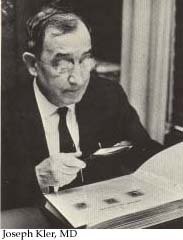 In July, Meaghan E. H. Siekman wrote about her great-grandfather, the Chicago-born son of Czech immigrants who
In July, Meaghan E. H. Siekman wrote about her great-grandfather, the Chicago-born son of Czech immigrants who
spent his lifetime chasing the American dream and preserving a history which was not directly his own, as none of his ancestors ever lived in colonial America. Evidence of the importance of American history in his life can be found in his obituary, which focuses more on his collections [parts of which ended up in the Smithsonian Institution] and preservation work than his career in medicine.
From the perspective of his great-granddaughter, Joseph’s efforts were a part of his desire to truly be American and to pass on that pride of country to his children and their children. He saw himself as fully American. The sense of a Czech identity never reached me, though I know from learning more about Joseph Kler that his love of American history was passed to his daughter (my grandmother), to her son (my father), and then to me. I hope to carry forward Joseph’s sense of civic duty in the preservation of American history and by sharing his pride in being American.
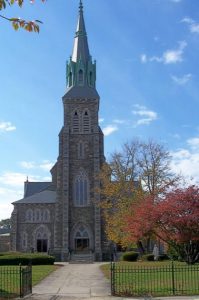 As part of his work managing the Historic Catholic Records Online project, Sam Sturgis reviewed the overlap between civil vital records and the records generated by St. Patrick’s Church in Lowell to see if problematic names, obscured by the recorders’ indecipherable handwriting, could be found in both places:
As part of his work managing the Historic Catholic Records Online project, Sam Sturgis reviewed the overlap between civil vital records and the records generated by St. Patrick’s Church in Lowell to see if problematic names, obscured by the recorders’ indecipherable handwriting, could be found in both places:
The Massachusetts VR birth records for Lowell in 1862 consist of 757 entries on pages 164–81 of record volume 151. I downloaded this set of records from FamilySearch.org (which includes full dates) and compared them to the 371 birth records from Saint Patrick’s parish for the same year. Allowing for minor variation in the surname, given name, and/or complete date, I only found 139 matches. In other words, only about 40% of the births recorded in the church were also recorded by the town.
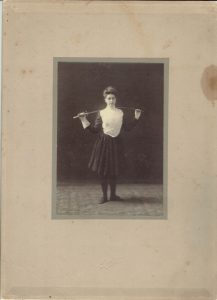 Jan Doerr turned to old newspapers to better understand her grandparents’ early lives:
Jan Doerr turned to old newspapers to better understand her grandparents’ early lives:
It was the photos of Rex and Winifred in fencing suits that caught my attention: they had never said anything about being fencers, no stories or newspaper articles were in evidence, and of course, I never asked about the framed photos that were always on the wall in the den, probably because they were always on the wall in the den.
Once again, old newspapers have surfaced to shed more light on their activities as young adults. In the Boston Globe archives, my son found an article about Rex Church’s participation in the Pianelli Fencing Club in Augusta, Maine. Apparently my grandfather, long after his marriage, continued to fence in Augusta, and competed against the Bowdoin College and the Bangor Y.M.C.A. teams.
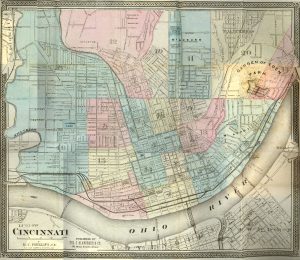 Zachary Garceau offered Vita Brevis readers a primer for Cincinnati genealogical research: from probate records to cemetery burial databases, from local genealogical societies to the Ohio resources at national genealogical websites, his post offers researchers with Cincinnati interests a fund of information to consider. As he notes,
Zachary Garceau offered Vita Brevis readers a primer for Cincinnati genealogical research: from probate records to cemetery burial databases, from local genealogical societies to the Ohio resources at national genealogical websites, his post offers researchers with Cincinnati interests a fund of information to consider. As he notes,
German heritage and ancestry has long been an important facet of the culture of Cincinnati, and understanding and studying the roots of this heritage is equally important. More than ever before, genealogists and researchers have the ability to trace the ancestry of the Germans who helped to shape the Queen City.
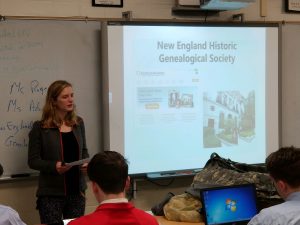 Molly Rogers described a visit to a local school to introduce history students to the Society’s Catholic records project (see above) and to challenge them to decode the cursive script of nineteenth-century recordkeeping. Her NEHGS colleague Rachel Adams
Molly Rogers described a visit to a local school to introduce history students to the Society’s Catholic records project (see above) and to challenge them to decode the cursive script of nineteenth-century recordkeeping. Her NEHGS colleague Rachel Adams
spoke about the process of digitization – how something goes from a book or a manuscript to becoming part of our online database. She explained exactly how the students would be helping us. Each group of two or three students was assigned a page with about seven baptismal records. Rachel explained where to find the various important bits of information on the page, like the date, the name, the parents’ names, and the witnesses’ names. She gave the students tips for reading the messy handwriting, such as comparing a problem letter to other letters on the page. After our presentation, the students had the rest of the class to start working, as we roamed the classroom offering advice.
The results of this class project suggest that the students enjoyed engaging with the hitherto alien handwriting of “the old days” – and they certainly became conversant with some of the features of handwritten church records.
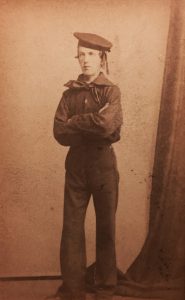 The most recent blogger to join the Vita Brevis masthead is Alessandro Ferzoco, of the Research Services team. In his initial post, he described the Civil War naval service of his great-grandfather, Hugh A. Crossen, and Alessandro’s efforts to locate Hugh’s grave in a Cambridge cemetery:
The most recent blogger to join the Vita Brevis masthead is Alessandro Ferzoco, of the Research Services team. In his initial post, he described the Civil War naval service of his great-grandfather, Hugh A. Crossen, and Alessandro’s efforts to locate Hugh’s grave in a Cambridge cemetery:
The signage in the cemetery is poor – some trees have faded letters on them, but no maps exist to guide visitors to a given grave. I had called the Archdiocese of Boston and learned the plot and grave where Hugh was interred; however, they were unable to provide any visual guide for finding the grave. I was undeterred, as it was a sunny fall afternoon, and so I meandered through the largely abandoned cemetery, strewn with fallen tree limbs and broken headstones, looking for clues.
After about an hour I came across a small military headstone. Occasional weed-whacking had disturbed the lowermost part of this stone enough that no moss grew across a band of a few inches, leaving the words “U.S. Navy” exposed. The rest of the stone was blanketed in a thick blanket of moss and indecipherable.
I crouched over, began scratching away the moss and lichen with a small branch. To my delight and amazement, the letters soon emerged in an arching, semicircular formation – HUGH A. CROSSEN…
Share this:
About Scott C. Steward
Scott C. Steward has been NEHGS’ Editor-in-Chief since 2013. He is the author, co-author, or editor of genealogies of the Ayer, Le Roy, Lowell, Saltonstall, Thorndike, and Winthrop families. His articles have appeared in The New England Historical and Genealogical Register, NEXUS, New England Ancestors, American Ancestors, and The Pennsylvania Genealogical Magazine, and he has written book reviews for the Register, The New York Genealogical and Biographical Record, and the National Genealogical Society Quarterly.View all posts by Scott C. Steward →